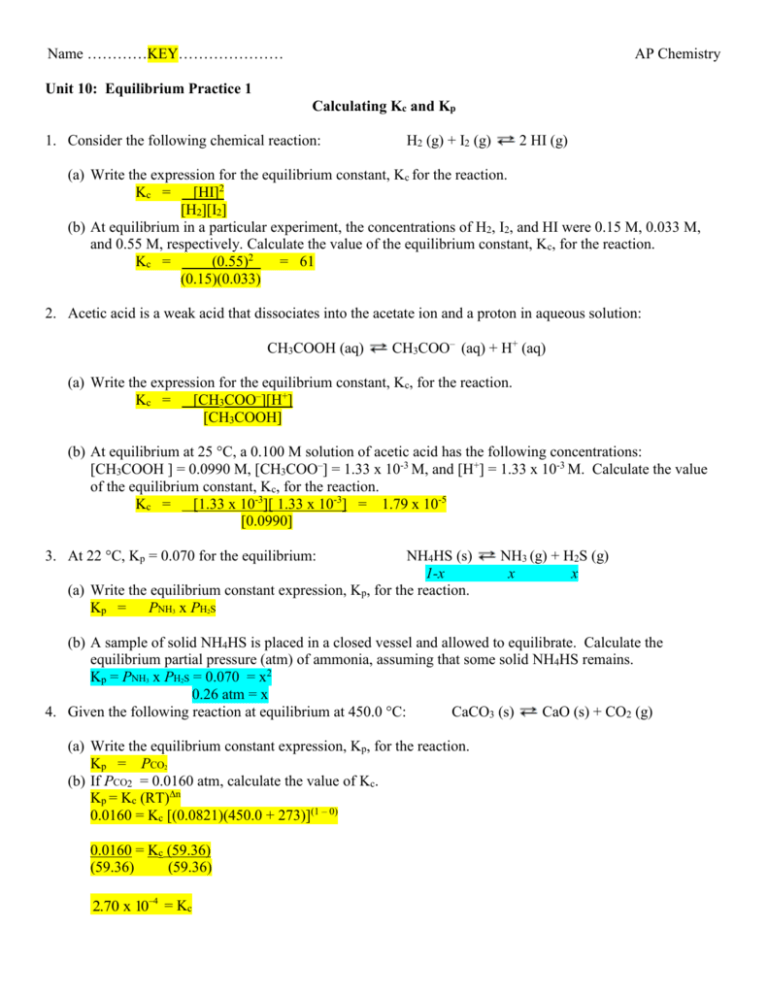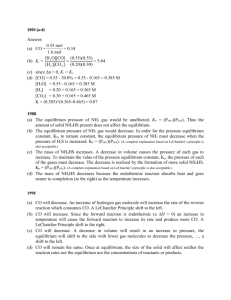KEY - Equilibrium Practice 1
advertisement

Name …………KEY………………… AP Chemistry Unit 10: Equilibrium Practice 1 Calculating Kc and Kp 1. Consider the following chemical reaction: H2 (g) + I2 (g) 2 HI (g) (a) Write the expression for the equilibrium constant, Kc for the reaction. Kc = [HI]2 [H2][I2] (b) At equilibrium in a particular experiment, the concentrations of H2, I2, and HI were 0.15 M, 0.033 M, and 0.55 M, respectively. Calculate the value of the equilibrium constant, Kc, for the reaction. Kc = (0.55)2 = 61 (0.15)(0.033) 2. Acetic acid is a weak acid that dissociates into the acetate ion and a proton in aqueous solution: CH3COOH (aq) CH3COO– (aq) + H+ (aq) (a) Write the expression for the equilibrium constant, Kc, for the reaction. Kc = [CH3COO–][H+] [CH3COOH] (b) At equilibrium at 25 °C, a 0.100 M solution of acetic acid has the following concentrations: [CH3COOH ] = 0.0990 M, [CH3COO–] = 1.33 x 10-3 M, and [H+] = 1.33 x 10-3 M. Calculate the value of the equilibrium constant, Kc, for the reaction. Kc = [1.33 x 10-3][ 1.33 x 10-3] = 1.79 x 10-5 [0.0990] 3. At 22 °C, Kp = 0.070 for the equilibrium: NH4HS (s) 1-x (a) Write the equilibrium constant expression, Kp, for the reaction. Kp = PNH3 x PH2S NH3 (g) + H2S (g) x x (b) A sample of solid NH4HS is placed in a closed vessel and allowed to equilibrate. Calculate the equilibrium partial pressure (atm) of ammonia, assuming that some solid NH4HS remains. Kp = PNH3 x PH2S = 0.070 = x2 0.26 atm = x 4. Given the following reaction at equilibrium at 450.0 °C: CaCO3 (s) CaO (s) + CO2 (g) (a) Write the equilibrium constant expression, Kp, for the reaction. Kp = PCO2 (b) If PCO2 = 0.0160 atm, calculate the value of Kc. Kp = Kc (RT)∆n 0.0160 = Kc [(0.0821)(450.0 + 273)](1 – 0) 0.0160 = Kc (59.36) (59.36) (59.36) 2.70 x 104 = Kc 5. Given the following reaction at equilibrium: PCl5 (g) PCl3 (g) + Cl2 (g) (a) Write the equilibrium constant expression, Kp, for the reaction. Kp = PCl2 x PPCl3 PPCl5 (b) At 250. 0°C, Kp = 1.05. Calculate the value of Kc at this temperature. Kp = Kc (RT)∆n 1.05 = Kc [(0.0821)(250.0 + 273)](2 – 1) 1.05 = Kc (42.94) (42.94) (42.94) 2.45 x 102 = Kc 6. Kp = 0.0198 at 721 K for the reaction: 2 HI (g) H2 (g) + I2 (g) (a) In a particular experiment, the partial pressures of H2 and I2 at equilibrium are 0.710 and 0.888 atm, respectively. Calculate the partial pressure of HI (g) at equilibrium. Kp = PH2 x PI2 P2HI P2HI = PH2 x PI2 Kp 2 P HI = 0.710 x 0.888 0.0198 2 P HI = 31.8 P HI = 5.64 atm (b) Calculate the value of Kc at this temperature. Kp = Kc (RT)∆n 0.0198 = Kc (0.0821 x 721)(2-2) 0.0198 = Kc (1) 1.98 x 10-2 = Kc 7. Given the following reaction at equilibrium: 2 NO (g) + O2 (g) 2 NO2 (g) (a) In terms of molar concentrations, write the equilibrium constant expression for the reaction above. Kc = [NO2]2 [NO]2[O2] (b) At 230.°C, Kc = 6.44 x 105. Calculate the value of Kp. Kp = Kc (RT)∆n Kp = 6.44 x 105 [(0.0821)(230. + 273)](2-3) Kp = 6.44 x 105 [41.3](-1) Kp = 1.56 x 104 (c) Calculate the partial pressure of NO2 (g) if PNO = 0.110 atm and PO2 = 0.236 atm at 230.°C. 6.67 atm Kp = P2NO2 = 1.56 x 104 P2NO x PO2 P2NO2 = 1.56 x 104 2 (0.110) (0.236) P2NO2 = 1.56 x 104(0.110)2 (0.236) = 44.55 P NO2 = 6.67 atm Remember that “Q” is the “reaction quotient”, an expression which tells the relative amounts of products and reactants at any given time during a chemical reaction. At equilibrium, Q = Keq If Q is greater than Keq, there is a lot of PRODUCT, so the reaction shifts to the LEFT to make more reactants and establish equilibrium If Q is less than Keq, there is a lot of REACTANT, so the reaction shifts to the RIGHT to make more products and establish equilibrium 1. N2(g) + 3 H2 (g) 2 NH3 (g) For the reaction represented above, the value of the equilibrium constant, Kp, is 3.1 x 10-4 at 700. K. (a) Write the expression for the equilibrium constant, Kp, for the reaction. Kp = P2NH3 PN2 x P3H2 (b) Assume that the initial partial pressures of the gases are as follows: PN2 = 0.411 atm, PH2 = 0.903 atm, and PNH3 = 0.224 atm. (i) Calculate the value of the reaction quotient, Q, at these initial conditions. Q = (0.224)2 = 0.166 3 (0.411)(0.903) (ii) Predict the direction in which the reaction will proceed at 700. K if the initial partial pressures are those given above. Justify your answer. Since Q is greater than Kp, there is a lot of product. The reaction will shift to the left to make more reactants to reach equilibrium. (c) Calculate the value of the equilibrium constant, Kc, for the reaction. Kp = Kc (RT)∆n 3.1 x 10-4 = Kc [(0.0821)(700.)](2-4) 3.1 x 10-4 = Kc (57.47)–2 (57.47)–2 (57.47)–2 1.0 = Kc 2. The value of Kp for the reaction below is 8.7 x 10-3 at 700. K. NH3 (g) + H2S (g) NH4HS (g) (a) Write the expression for the equilibrium constant, Kp, for the reaction. Kp = PNH4HS PNH3 x PH2S (b) Assume that the initial partial pressures of the gases are as follows: PNH3 = 0.823 atm, PH2S = 0.995 atm, and PNH4HS = 0.007 atm. (i) Calculate the value of the reaction quotient, Q, at these initial conditions. 8.55 x 10-3 Q = PNH4HS = 0.007 = 8.55 x 10-3 PNH3 x PH2S (0.823)(0.995) (ii) Predict the direction in which the reaction will proceed at 700. K if the initial partial pressures are those given above. Justify your answer. Since Q is less than Kp, there are more reactants than products, and the reaction will shift to the right to make more products to reach equilibrium. (c) Calculate the value of the equilibrium constant, Kc, for the reaction. Kp = Kc (RT)∆n 8.7 x 10-3 = Kc [(0.0821)(700.)](1-2) 8.7 x 10-3 = Kc (57.47)–1 (57.47)–1 (57.47)–1 0.50 = Kc








